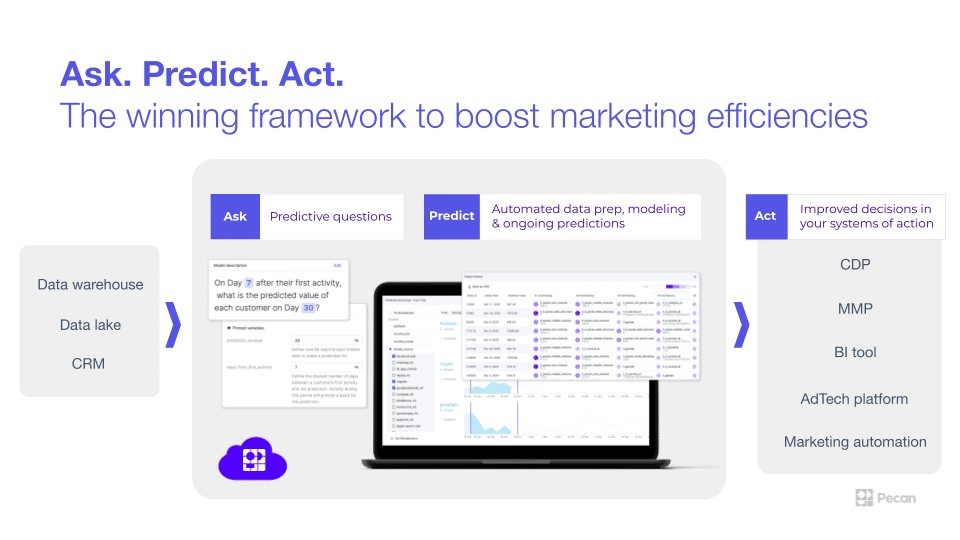Digital marketing has transformed the way brands engage with customers. New avenues such as email, social media, and personalization tools let them speak directly and authentically with each customer. Segmentation tools like CDPs help create unified customer profiles and automated workflows, reducing manual effort and allowing marketers to focus on higher-value tasks.
However, as the complexity of these channels grows, executing campaigns and measuring effectiveness has become increasingly challenging. Recent changes to technology rules by Apple, Google, and Meta have added to the complexity.
As a result, it’s become essential for brands to leverage machine learning to measure their ad campaigns. Machine learning can help overcome the challenges associated with traditional rule-based attribution models by analyzing vast amounts of data and detecting patterns and insights that humans can’t see.
Leveraging machine learning can give brands a competitive edge in their marketing strategies, optimizing their campaigns to drive growth and customer engagement. As the digital marketing landscape continues to evolve and become more complex, the time to adopt machine learning is now.
In this post, I’ll outline some key measurement challenges brands can overcome with machine learning, how machine learning will power the future of online attribution, and how you can get started today with a low-code predictive analytics platform.
Measurement challenges brands can overcome with machine learning
As the media landscape continues to evolve, it has become increasingly difficult to orchestrate successful ad campaigns while also proving their value. In fact, according to a recent Forrester report, approximately 71% of B2C marketing executives find it “very challenging” or “extremely challenging” to demonstrate value to the CEO, CFO, and board.
With the proliferation of digital channels and the vast amount of data available, measuring and proving the effectiveness of marketing campaigns has become more complex than ever before. The challenge lies in analyzing and interpreting the data to provide meaningful insights and evidence of ROI.
Marketing executives must demonstrate their ability to deliver measurable results that align with overall business objectives. To do this, they need to leverage advanced technologies such as machine learning, which can analyze vast amounts of data and provide accurate insights into the effectiveness of marketing campaigns.
By adopting machine learning, marketing teams can better demonstrate the value of their campaigns to the C-suite and board members, enabling them to make more informed decisions and justify marketing investments.
With machine learning, brands can overcome many of the attribution challenges we’re currently facing.
Data availability
With the increasing amount of data available through digital channels, more than traditional rule-based attribution models may be required. Machine learning can process vast amounts of data and detect patterns and insights that rule-based models miss.
As McKinsey has stated, we now have over 80 million zettabytes of data, and in five years, we will have over 300 million. Humans need the help of AI and machine learning to contend with so much data.
Complex customer journeys
As noted in Forbes, the customer journey has become more complex over the years. Users interact with brands across multiple touchpoints and devices. Machine learning models can analyze the entire customer journey and provide a more accurate picture of the impact of each touchpoint.
Mobile measurement
With the introduction of Apple’s ATT framework, brands lost a significant amount of campaign data due to tracking restrictions. However, now, with machine learning, brands are able to regain roughly 85% of the lost mobile data for mobile ad campaigns.
Competitive advantage
Adopting machine learning can provide a competitive advantage by enabling advertisers and marketers to refine optimizations and bid on audiences that their competitors may not be prioritizing.
As a result, teams can analyze campaign results earlier in the campaign lifecycle and predict which campaigns are likely to drive higher LTV. With this predictive lens, the marketing team always looks 6-9 months ahead vs. focusing on Day 7 campaign results.
How will ML power the future of online attribution?
As the AI market matures and marketers adopt predictive analytics, I believe there are four ways machine learning will support online attribution methods.
Filling in missing data
Mobile campaigns are affected by missing data. Knowing the state of online cookies (2024’s Google cookie deprecation) and that 75% of marketers are reliant on third-party cookies, there’s a growing need for technology to fill the gaps of a cookieless digital ecosystem.
A move toward integrated measurement
As cookies become less significant, first-touch or last-touch campaign attribution will become less important. Instead, brands will start looking at their entire marketing mix through the lens of marketing mix modeling and analyzing how each channel drives incrementality.
Earlier optimization
Predictive analytics can help optimize marketing campaigns earlier in the campaign process by identifying the most effective combinations of channels, messaging, and offers. This approach can help businesses save time and resources while maximizing the ROI of their marketing efforts.
Future planning
Predictive analytics can provide a glimpse of the future of campaign performance, customer behavior, and customer lifetime value. This future perspective allows businesses to not only improve ad campaigns, but also understand how to keep existing customers happy and drive higher lifetime value via upsell/cross-sell opportunities.
How you can get started today with predictive analytics
Predictive analytics isn’t new, and many marketing teams may already have tried to use predictive models. However, the typical approach to building those models has required the involvement of data scientists and MLOps engineers who handle data infrastructure and hand-coding of models. Marketing teams usually have to partner with in-house data science teams or external consultants to build predictive models.
Unfortunately, that relationship hasn’t always been straightforward. In recent industry research commissioned by Pecan AI, “The State of Predictive Analytics in Marketing 2022,” 40% of our survey respondents said that those who built predictive models for the marketing team didn’t understand marketing’s goals.
Now, with the use of tools like Pecan AI, marketing analysts who know the marketing team’s data best and understand the team’s goals can use their existing data expertise to build predictive models. Rather than competing for in-house resources, they can bring AI into their own groups and manage the entire data science process end to end.
With predictive modeling tools at their fingertips, marketing analysts can provide the future perspective needed to inform conversations and optimizations. Better decisions about those matters mean marketing goals can be reached on time and within budget. And this all starts with a predictive framework.
The Ask. Predict. Act. framework provides a structured approach to integrating AI into the marketing workflow, helping teams to use AI to achieve their marketing goals and measure campaigns effectively.
To get started with a ML-based approach to campaign attribution, marketers need to:
Ask: define goals and objectives. This task could involve identifying the problems they want AI to solve or the outcomes they want to achieve.
Predict: use predictive analytics to analyze the data gathered in the Ask phase. With an automated platform like Pecan, cleaning and preparing the data, choosing the right AI algorithms, and training the AI model are all handled behind the scenes. This phase aims to generate meaningful insights and predictions that can inform marketing decisions.
Act: In this phase, teams use the insights and predictions generated by AI to make data-driven decisions and take action. This process may involve modifying existing campaigns, creating new campaigns, or adjusting the data and algorithms used by AI. Teams should also continuously monitor and evaluate the performance of AI, making adjustments as needed to ensure they are achieving their desired outcomes. (Again, an automated platform like Pecan can deal with these ongoing monitoring and adjustment steps so humans can focus on taking meaningful, creative action in their marketing efforts.)
Overall, predictive analytics has the potential to transform marketing attribution by providing businesses with more accurate and actionable insights into customer behavior. By leveraging machine learning algorithms to analyze data from various touchpoints and channels, businesses can optimize their marketing efforts and increase sales in a highly competitive online marketplace.
Ready to Get Started?
Get in touch to learn more about how machine learning can transform your team’s marketing measurement. Contact us to set up a demo and begin your shift to a future-focused approach today.






